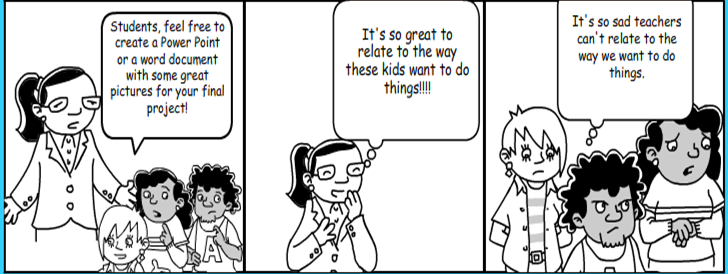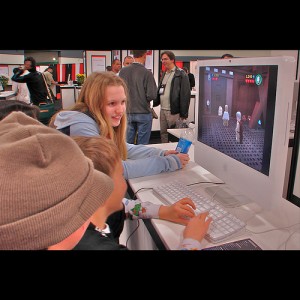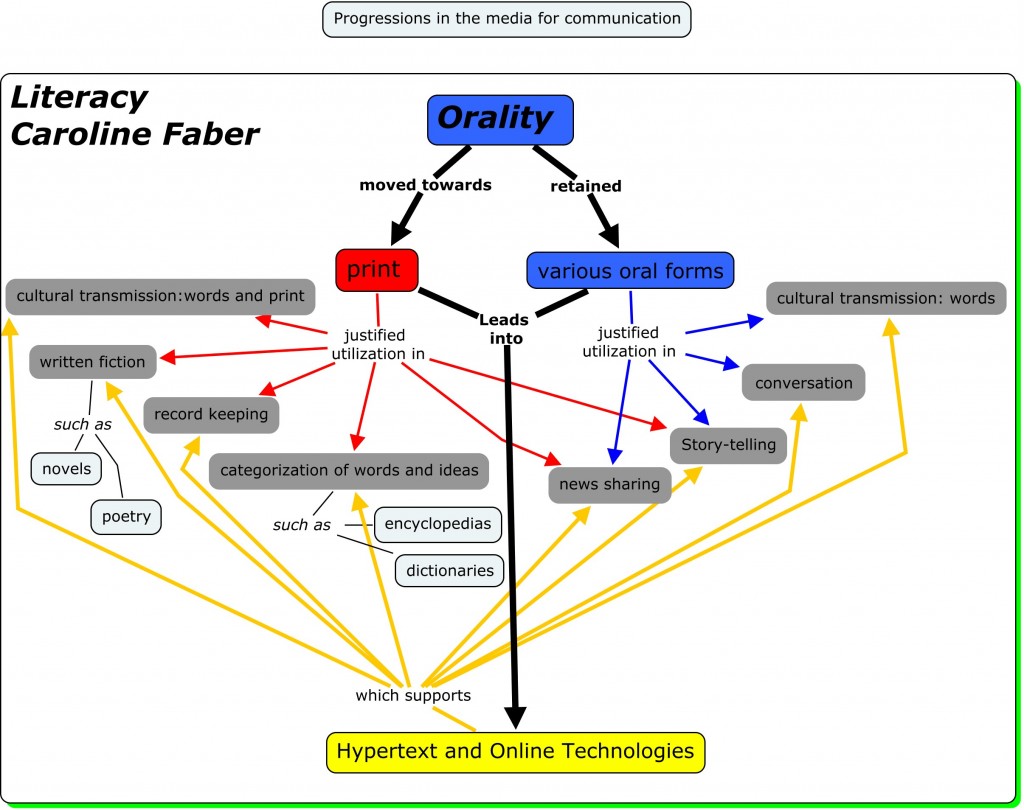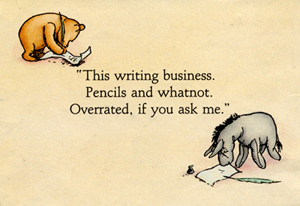A Concept-Driven Curriculum and Educational Technology Integration
In 2001, Mark Prensky, an influential voice in the field of educational technology, considered students in kindergarten-college, who were born into a technically advanced society, to be “Digital Natives”. Prensky’s (2001) Digital Natives were the first generation literate in the digital language of computers, the Internet and video games. Individuals born prior to the introduction of home computers and broadband are considered Digital Immigrants, and they speak “digital” with a strong accent (Prensky, 2001). Similar to Prensky, Don Tapscott (1998) considered students born between 1977 and 1997 to be members of the Net Generation, a generation of critical thinkers who question the values contained in information. The Net Generation have “grown up digital” and in 2009, we are teaching the new Net Generation, some members who are being raised by the first “Net Geners” (Tapscott, 2009). Curriculums will never catch up with the digital language this generation speaks unless there is a shift toward centering the learning experience on the individual and providing learners with the tools of new media to enhance interactivity and, importantly, constructivist connections (Tapscott,1998).
In 2007, cultural anthropologist Michael Wesch posted a video concerning this issue on YouTube. The video, A Vision of Students Today, emphasises how the educational system of the 20th century fails to meet the needs of the 21st century learner. Web development never slowed down to let Digital Immigrants catch up. In 2004, Tim O’Reilly coined the phrase “Web 2.0” and the new Net Generation spoke another digital language dialect (Alexander, 2008). Educators inhabiting the world of the new Net Generation must revamp and extend their prior technology skills to address emergent multiliteracies in the Web 2.0 world (Alexander, 2008). An exploration of how the PYP could meet the needs of the new Net Generation learner through the educational design of a concept-driven curriculum opens up learning possibilities for student and teacher.
The concept driven curriculum in the PYP is a pedagogical approach to learning and teaching that supports inquiry based learning (IBO, 2009). The eight key concepts identified in the PYP (form, function, causation, change, connection, perspective, responsibility and reflection) support the transdisciplinary model of teaching and learning (IBO, 2009). Integrating educational technology opportunities, specifically Web 2.0 tools, into a concept driven curriculum is one way to enrich lines of inquiry (Alexander, 2006; Levy, 2008; Reid, 2007; Wesch, 2007). Web 2.0 tools give educators the means to incorporate digital literacy opportunities into the inquiry process to help meet the transdisciplinary learning needs of the new Net Generation (Alexander, 2006; Bolter, 2001; Cameron, 2004; Prensky, 2008).
The selection of Web 2.0 tools is dependent on a number of factors, not all of which can be discussed here. For the sake of making reasonable recommendations, it is assumed that the digital divide in Hong Kong IB schools is not a severe restrictive concern. Students need access to a computer with a reliable Internet connection and teachers may require in-house technical support (Bates, 2000). It is also assumed that educational technology integration has been discussed at the administrative level and the school has a general atmosphere of culture change in favour of designing educational spaces with Web 2.0 technology. Staff enthusiasm for learning new Web 2.0 tools in an already stretched schedule is one indicator of this cultural change (Bates, 2000). It is recommended that the terms of service and privacy policies for Web 2.0 applications be analyzed with the school’s online student safety and intellectual property policies in mind (ISTE, 2008). Finally, grade level planning meetings concerning how concepts could be supported with specific technologies during the inquiry planning process would clarify the purpose of the Web 2.0 tool.

(ICT Enhanced Interative Writing, 2009)
A number of Web 2.0 technologies are available to teachers and choosing a tool may seem daunting. However, it is up to the teacher to decide how the tool could be integrated to make concepts in the planner relevant to the student. Alexander (2006; 2008), in his discussion of multiliteracies, identifies four qualities of Web 2.0 tools which help students develop their digital literacy. They are considered by Alexander (2008) to be the creation of microcontent, social connectedness, openness and social filtering. The new Net Generation speaks this language and learns in this manner (Bolter, 2001; Anderson 2008). When choosing tools it is important to identify characteristics of the new Net Generation in order to inform educational design. These students desire faster interactions with information, multitasking, processing multiple data simultaneously, informative graphics with a text backup, hyperlinking through materials rather than reading linearly, networking with electronic communication devices, immediate and clear feedback or reward in return for efforts (Bolter, 2001; Cameron, 2004). Our students see technology as empowering and necessary (Bolter, 2001; Cameron, 2004).
 (“Ed-Tech 1.0 Meets 2.0”, Gillespie, 2009. Created on MakeBeliefsComix)
(“Ed-Tech 1.0 Meets 2.0”, Gillespie, 2009. Created on MakeBeliefsComix)
Digital storytelling and the emergent form of Web 2.0 digital storytelling is a tool popular with educators (Banaszewski, 2002; Benmayor, 2008; Meadows, 2003). Enthusiast, educator and Web 2.0 researcher Alan Levine has created an excellent resource for anyone interested in Web 2.0 digital storytelling at http://cogdogroo.wikispaces.com/StoryTools. Blogging and wikis have been popular for over a decade and both have been researched and found to be supportive of constructivist learning opportunities. Some recommended tools are Landmarks’ Class Blogmeister (http://www.classblogmeister.com/), Edublogs (http://edublogs.org/), Wikimedia’s Wikikids (http://meta.wikimedia.org/wiki/Wikikids) and PB Works (https://plans.pbworks.com/academic). For a snapshot of wikis in use, visit Educational Wikis (http://educationalwikis.wikispaces.com/Examples+of+educational+wikis).
Other excellent Web 2.0 tools to support digital literacy and inquiry are Kerpoof Studios (http://www.kerpoof.com/), M.I.T’s Scratch (http://scratch.mit.edu/), Make Beliefs Comix (http://www.makebeliefscomix.com/Comix/), Voice Thread (http://voicethread.com/) , Prezi (http://prezi.com/), Gliffy diagram software (http://www.gliffy.com/) , the Jing screen capture application (http://www.jingproject.com/) and the sound editor Audacity (http://audacity.sourceforge.net/). Creative Commons (http://creativecommons.org/) is an excellent place for student and teacher to search for “copyleft” and reusable and web content. The above Web 2.0 tools are designed in English, but some lend themselves to bilingual content. Generally, they are tools which can be mixed and “remixed” with one another. For example, a wiki could have an embedded 2.0 digital story which is itself hyperlinked to a blog in order to meet the student’s digital literacy preference for nonlinear reading. In addition, the forums on the ibo.org online curriculum centre (OCC) are rich resources concerning the practical implementation of Web 2.0 tools. Several Ning (http://www.ning.com/) networks, wikis and TED (http://www.ted.com/) talks have been created by IB educators for IB educators.
Our students are memory stick carrying members of the new Net Generation, a generation defining emergent multiliteracies. In a knowledge society, our learners need liberal arts skills to be integrated with information technology (Bates, 2000). It is the educator’s responsibility to integrate tools with meaningful relevance to our 21st century students in order to help them reach their greatest potential when navigating a concept based inquiry. Today’s students live Web 2.0 digital lives and a growing number of teachers are beginning to explore and develop new ways of teaching with these technologies and practices (Alexander, 2008). It is the intention of this article to provide inspiration for IB teachers to integrate Web 2.0 tools in order to help students construct knowledge necessary for a meaningful understanding of concepts.
References
Alexander, B. (2006). Web 2.0: A new wave of innovation for teaching and learning? EDUCAUSE Review, 41(2), 32-44. Retrieved from http://net.educause.edu/ir/library/pdf/ERM0621.pdf.
Alexander, B. (2008). Web 2.0 and emergent multiliteracies. Theory into Practice, 47(2), 150-160. doi: 10.1080/00405840801992371
Bates, T. (2000). Managing technological change: Strategies for college and university leaders. San Francisco: Jossey-Bass.
Beetham,H., & Sharpe, R. (2007). An introduction to rethinking pedagogy for a digital age. In H. Bentham & R. Sharpe (Eds.), Rethinking Pedagogy for a Digital Age. (pp 1-10). London:Routeledge
Bolter, J. D. (2001). Writing space: Computers, hypertext, and the remediation of print. Mahwah, New Jersey: Lawrence Erlbaum Associates.
Cameron, D. (2004). The net generation goes to university? Journalism Education Association Conference , Griffith University. Available online from http://www.eric.ed.gov/ERICDocs/data/ericdocs2sql/content_storage_01/0000019b/80/28/08/25.pdf
International Baccalaureate Organization. (2009). The IB primary years programme. Available online from http://www.ibo.org/pyp/
International Society for Technology in Education [ISTE]. (2008). ISTE’s Educational Technology Standards for Teachers. Available online from http://www.iste.org/Content/NavigationMenu/NETS/ForTeachers/2008Standards/NETS_for_Teachers_2008.htm
Lamb, B. (2007). Dr. Mashup or, why educators should learn to stop worrying and love the remix. EDUCAUSE Review, 42(4). 12-24.
Levy, P. (2008). Inquiry in the Web 2.0 environment: Tools for students for ‘design for learning’? Learning Through Enquiry Alliance Conference 2008. Available online from http://www.slideshare.net/cilass.slideshare/nquiry-in-the-web-20-environment-tools-for-students-for-design-for-learning
Reid, P. (2007). Inquiry based learning with Web 2.0. Educational Computing Association of Western Australia 2007 Conference Proceedings. Available online from http://www.slideshare.net/paulreid/inquiry-b-lweb20-ss
Prensky, M. (2001). Digital natives, digital immigrants. On the Horizon, 9(5), 1-6. Available online from http://www.marcprensky.com/writing/Prensky%20-%20Digital%20Natives,%20Digital%20Immigrants%20-%20Part1.pdf
Prensky, M. (2006). “Don’t bother me mom-I’m learning!” St. Paul, Minnesota: Paragon House
Tapscott, D. (1998). Growing up digital: The rise of the Net generation. NY, New York: McGraw-Hill
Tapscott, D. (2009 ) . Grown up digital. NY, New York:McGraw-Hill.
Wesch, M. (2007). A vision of students today, video. Available online from https://www.youtube.com/watch?v=dGCJ46vyR9o
Image References
Kids and Computers. January 13, 2007. Flickr upload by shapeshift. Available online November 25, 2009, from http://www.flickr.com/photos/shapeshift/355874159/
Owen, H. (2009). The ICT Enhanced Iterative Writing Process \’;//.[Electronic Version]. Retrieved from www.flickr.com/photos/24289877@NO2/3638995407
Gillespie, E. (2009). Ed-tech 1.0 meets 2.0. Created on MakeBeliefsComix , GNU license




